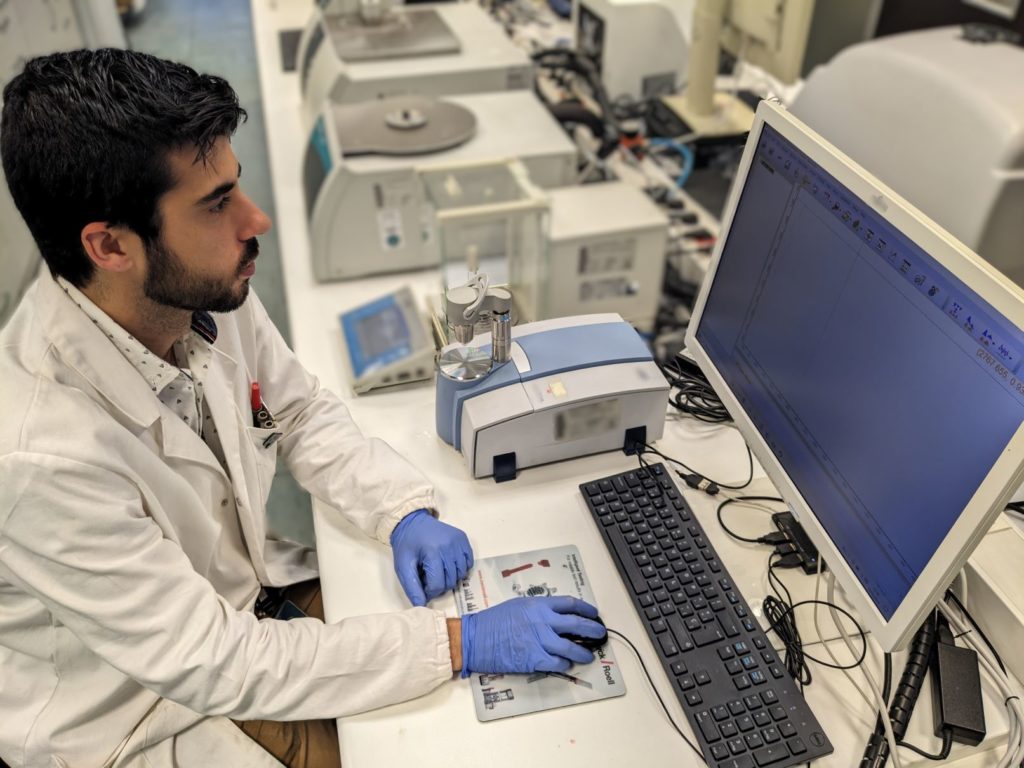Chemical analysis
Chemical analysis is a key step to understand the quality and composition of materials, as well as to develop new ones and comply with current regulations. For this purpose, Infinitia Industrial Consulting has a team of specialists who will provide their expertise to offer the best solution in each case.
Chemical analysis can be performed at any stage of the industrial process, from the reception of raw materials to the end of the value chain, in case there is a claim in the market, through the entire manufacturing process.
What does a chemical analysis of materials consist of
Chemical analysis of materials encompasses a wide range of techniques aimed at revealing the quality, composition and characteristics of certain products. For this purpose, Infinitia makes use of equipment such as infrared spectrophotometer, gas chromatograph or chromatography for liquid analysis (HPLC), among others, that make up a complete laboratory for materials analysis.
As manufacturing and product design incorporate the development of new composite materials, polymers, coatings and alloys, it is essential at each stage of production to identify precisely the materials involved.
A practical example of the application of chemical analysis in materials innovation can be found in the optimization and additivation of plastics and elastomers with antimicrobial actives, but there are many more cases where this step is useful.


Chemical analysis applications
Specialized knowledge of the industry and experience in applying the most relevant methodology are the keys to successful chemical testing. Advanced analytical techniques and instrumentation are required to solve problems or determine composition. These are some of the applications of chemical analysis:
Product characterization: they provide specific information on product composition.
Residue analysis: determine the causes of discolorations, stains and corrosion deposits.
Defect analysis and identification.
Comparison of batches of good and bad materials.
Failure analysis.
Method development.
Regulatory compliance.
Analytical and technical consulting services.
Contact with us
receive a tailored professional response
Types of chemical analysis
Industrial chemical laboratories perform tests and analyses including compositional testing, trace contamination detection, metal testing and failure identification that are used for manufacturing quality control and reverse engineering, such as physicochemical properties in a quality study of a processed food. These are some of the types of analysis that can be performed in a chemical laboratory:
They determine the chemical quality, identity, composition and impurities of materials by elucidating the molecular structure and confirming the chemical structure.
Chemical trace testing includes the analysis of trace metals and organic compounds with detection reaching trace and ultra-trace ranges, while chemical residue testing includes the analysis, detection and identification of residues to solve industrial problems.
Elementary analysis
Using a wide range of analytical techniques, laboratories identify and quantify the elemental composition of samples and chemical compounds. Sample types include organic and inorganic analyses, aqueous and non-aqueous materials and metals.
Resolving chemical contamination requires a rapid response. Chemical analysis makes it possible to quickly identify and resolve contamination problems.
Material testing and analysis
Chemical analysis of materials is indispensable in virtually every industrial sector, from specialty chemicals, nanomaterials development, materials innovation, petrochemicals, dyes and detergents, automotive, agrochemicals, metals, polymers, plastics, ceramics and even pharmaceuticals and consumer products.
These are analyses that identify and quantify the elemental composition of a metal alloy. They are extremely useful for manufacturing quality control, reverse engineering and failure investigation.
Chemical compliance testing
They serve to ensure that products comply with chemical regulations and are essential for some sectors such as agrochemicals, in the case of pesticides, or pharmaceuticals.
Chemical analysis techniques
Determining the composition of materials is possible thanks to advanced analytical techniques, including the following:
Mass Spectrometry (ICP MS)
Inductively coupled plasma mass spectrometry is a very sensitive elemental analysis technique that provides very low detection limits for most of the elements present in a sample, as in the case of the characterization of gases released by plastics.
Characterization of metal and polymer powders
Many test methods are employed, one of which uses laser light diffraction to determine particle size distribution.
C-S, O-N and H combustion tests
Carbon and sulfur analysis by combustion allows simultaneous quantification of these elements in metallic samples. Oxygen-nitrogen analysis and hydrogen analysis can also be used.
Optical emission spectrometry (ICP-OES)
Using this technique, an analysis is performed to represent the emission spectrum of chemicals. A solid sample is atomized by an arc spark discharge that provides sufficient energy to promote electrons from atoms to high energy levels. As the electrons return to their basic energy state, light is emitted.
X-ray diffraction (XRD)
One of the main uses of XRD analysis is the identification of crystalline phases for a wide variety of powders and thin film samples. It addresses the analysis of corrosion products, ceramics, clays, oxide or nitride coatings and many others.
X-ray fluorescence spectrometry (XFS)
XRF is a non-destructive semi-quantitative analysis applicable on a wide variety of materials including metals, polymers, liquids and soils.
We can conclude that chemical analysis of components offers verification of materials according to regulations and provides detailed information on their composition and thus their behavior in their intended use. They also enable the creation, design and development of new materials.
Oxidation induction time and temperature
The differential scanning calorimeter will be the tool used to measure both oxidation induction time (OIT) and temperature (OIT). This is a method that reveals the oxidation stability of materials such as polymers, fuels, oils or greases.
In Infinitia we have extensive experience in testing and chemical analysis of materials and our professionals offer the best quality assurance. If you need to perform a materials analysis or you are thinking of developing a new product, please contact our team.
Contact with us
receive a tailored professional response




